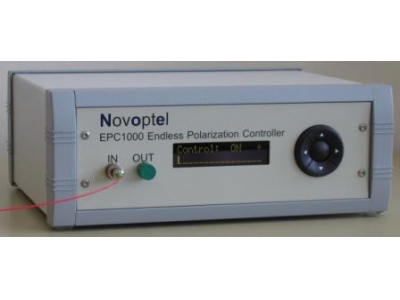EPC1000 Polarization Controller/Demultiplexer
Key features
Ultrafast endless optical polarization control with guaranteed endless tracking (control) speed of 40 krad/s, 60 krad/s or even 100 krad/s
Tracking speed is guaranteed at normal, good optical signal quality.
Extremly reliable: More than 350 Gigarad were tracked in several extended tests.
To our knowledge, Novoptel’s endless polarization tracking speed is at least 100 times as high as that of competitor products. If you are aware of something better then please inform us so that we can correct this statement.
Wavelength range: C band; extendable to S, extended C, and L band
Temperature range: -10°C to +70°C; extension is possible.
Insertion loss: 3 to 5 dB (excluding splitting loss)
Miniaturized size (board without protruding rubber boot: 150 mm x 78 mm x 15 mm)
Various configurations and models are available. Polarization demultiplexing based on residual interference detection is possible. Cost-saving version demultiplexes both DQPSK or QAM polarization channels.
Options: User-supplied error signal, other modulation formats,
arbitrary and endlessly variable output polarization, ...EPX1000 = cost-saving desktop unit with combined functionalities of EPC1000 and 10 Mrad/s polarization scrambler/transformer EPS1000
Low power consumption: ~5 W from single +5 V source. Depends on desired maximum tracking speed. Compatible with the needs of 40 Gb/s, 100 GbE, 2x100 GbE, 4x100 GbE and other transponders.
Interfaces for external controller or computer
Software commands (SPI) as well as digital hardware lines for important functions such as reset, control (on/off) and channel swapping (to exchange demultiplexed polarization channels). The latter may for example be activated by a framer/mapper which analyzes polarization channel information. Logic levels 3.3 V.
For special needs the standard values of important parameters (control gain and speed, delay and rise time of supplied error signal) can be modified by software commands.
Remote access possibility for diagnosis and troubleshooting
In-field upgradable firmware
Available as standalone unit in a desktop case, as plug-in card or as intellectual property core
Operation of standalone unit via control buttons or USB (software is included)
We are eager to accommodate special requirements.
Polarization and Phase Controller
Key features
Worldwide unique product: Endless optical polarization and phase (difference) control
Not only an unknown variable incoming polarization is transformed into a fixed output polarization, but also the phase difference between this polarization and its orthogonal is controlled, endlessly (without any interruption).
Indispensable for any application where optical polarization and phase control are needed:
general retarders with 3 and not just 2 deterministically controlled degrees-of-freedom,
optical phased arrays,
self-homodyne receivers with polarization beamsplitter for recovery of modulated signal and unmodulated LO with orthogonal polarizations and defined phase relation,
coherent optical receivers with simplified electronic signal processing,
fiberoptic quantum key distribution (QKD) based on BB84 or similar protocol implemented in the polarization domain.
Pilot signals (0°, 45°) in the frequency domain (wavelength domain) or in the time domain or user-supplied error signals
The whole normalized Stokes space of the probe signal is stabilized.
Endless tracking speed 20 krad/s (typically, in case of EPC1000 with phase control)
With pilot signals in the frequency domain: See this presentation and First Endless Optical Polarization and Phase Tracker (OFC/NFOEC 2013).
With pilot signals in the time domain for large PMD tolerance: See arXiv:2006.07351 [eess.SP].
We have developed more functionalities and are eager to accommodate special requirements.
Functional demonstration
 |  |
|
| Stabilization of normalized Stokes space of the probe signal, perfekt for QKD with BB84 | Traditional polarization control, does not work for QKD with BB84 |
|
Configurations of EPC1000
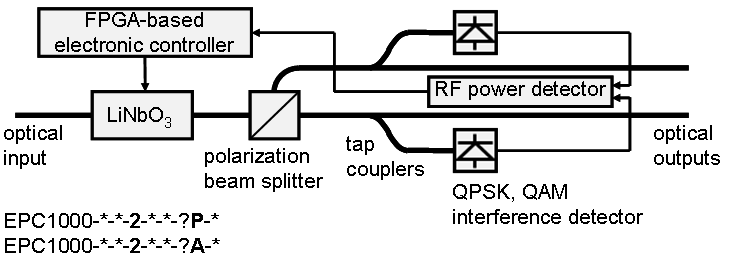
Standard configuration for polarization demultiplex of polarization-multiplexed QPSK or QAM signals. SMF or PMF outputs. Broadband interference between polarization channels is minimized, using photoreceivers and RF detector.

As above, but with only one output, for scenarios with high polarization-dependent loss. Two units are needed here to demultiplex both polarization channels.

Two outputs, user-supplied electrical error signal. This versatile configuration is adaptable for all special needs.

For polarized input signals (= having a single polarization). Cross-polarized signal intensity is minimized at second polarization beam splitter output. Co-polarized signal exits therefore with maximum intensity at main polarization beam splitter output.
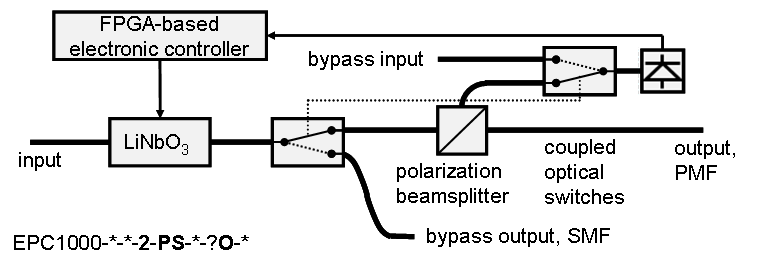
As above, but optical switches allow bypassing of polarization beamsplitter, for use of external polarization beamsplitter. Endless output polarization control available!
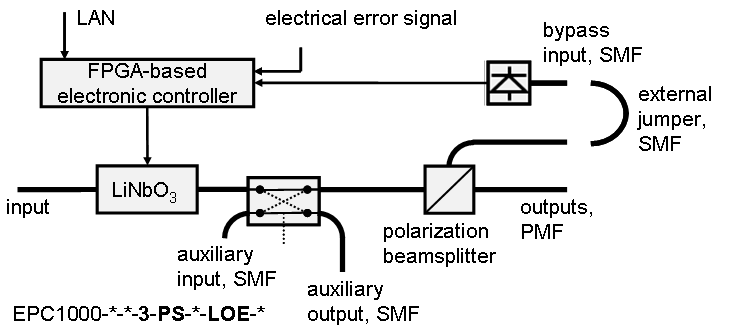
More versatile than above, 3 outputs, additional electrical error signal input, LAN connection (in addition to USB, SPI, JTAG). Endless output polarization control available!

Dual-polarization QPSK and QAM demultiplexing with interference detection, or single-polarization tracking with optical error signal 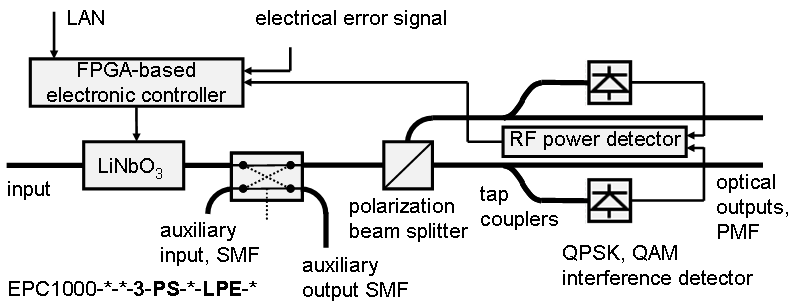
Dual-polarization QPSK and QAM demultiplexing with interference detection, or control based on electrical error signal. Endless output polarization control available.


